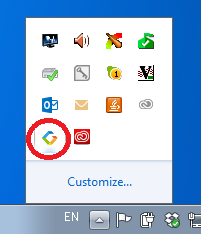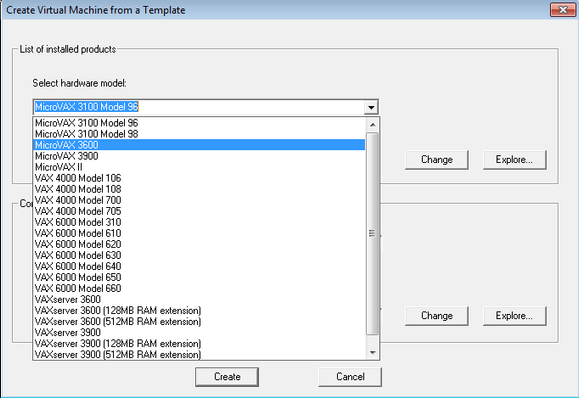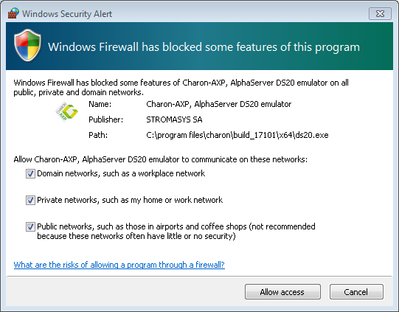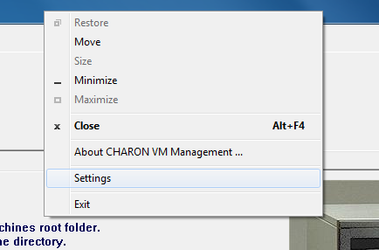Table of Contents
Starting CHARON Virtual Machines Manager
CHARON execution is controlled by the "CHARON Virtual Machines Manager" that manages each CHARON instance, called a "CHARON Virtual Machine", running on the host.
The CHARON installation procedure creates a shortcut on the desktop and under "Start" menu for the CHARON Virtual Machines Manager.
Desktop shortcut:
"Start" menu shortcut:
The CHARON Virtual Machines Manager runs automatically at Windows startup. If it is minimized to tray, it can be re-opened in the following way:
After clicking the shortcuts, the main dialog of CHARON Virtual Machines Manager appears.
Creating a CHARON Virtual Machine
Creating a CHARON VM using provided templates
CHARON installation contains a set of template files for creating a base configuration for each VAX/PDP11 model. Once CHARON Virtual Machine (VM) is created using these templates it can be configured further to meet your requirements and all the specifics of the emulated system.
By default the CHARON template does not contain any specification for disks and network; you need to update the configuration file created from the template to specify your specific disk and network configuration.
Start CHARON Virtual Machines Manager (see above) and press the "Create VM from Template" button:
In the appearing dialog select the VAX/PDP11 hardware model:
Note the Home Directory for the VM (see screenshot below), it will be used by default for storing logs, virtual disk images, toy and container files if no path is specified in the configuration file.
Specify a name for the VM and press the "Create" button:
CHARON Virtual Machines Manager will report the VM has been created successfully:
The created Virtual Machine will appear in the list of Virtual Machines (left pane):
Creating a CHARON VM using an existing configuration file
It is also possible to use any existing configuration file for creating a CHARON Virtual Machine.
Start CHARON Virtual Machines Manager (see above) and press the "Add Existing VM" button:
In the appearing dialog select the target configuration file by pressing the "Browse" button:
Select the configuration file and press the "Open" button:
Enter the CHARON Virtual Machine name and note the Home Directory for this VM, it will be used by default for storing logs, virtual disk images, toy and container files if no path is specified in the configuration file.
Press the "Create" button:
CHARON Virtual Machines Manager will report the VM has been created successfully:
The created Virtual Machine will appear in the list of Virtual Machines (left pane):
Running a CHARON Virtual Machine
Select the target CHARON VM in the left pane and press the "Start" button:
CHARON Virtual Machines Manager will display the execution log:
![]() Note the color meaning:
Note the color meaning:
| Colors | Meaning | Example |
|---|---|---|
Red | Error |
This is an error message
|
| Light blue | Warning |
This is a warning message
|
Light yellow | Information |
This is an informational message
|
Purple | Begin/End of the Windows system log |
Begin / End
|
The console of this particular CHARON VM will then appear (if defined in the configuration file):
Depending on settings, Windows may display a Firewall warning dialog asking to confirm CHARON access to different networks.
Check the desired options and press the "Allow access" button.
If you closed CHARON VM console it is always possible to re-open it by pressing the "Show Console" button:
![]() Closing the console will not stop the CHARON Virtual Machine
Closing the console will not stop the CHARON Virtual Machine
Stopping a CHARON Virtual Machine
![]() Note: before stopping the virtual machine from the CHARON Virtual Machines Manager, a clean shutdown of the operating system running on the VM has to be performed
Note: before stopping the virtual machine from the CHARON Virtual Machines Manager, a clean shutdown of the operating system running on the VM has to be performed
Select the target CHARON VM in the left pane and press the "Stop" button. A dialog will appear to confirm, select "Yes" to continue to stop the VM:
Removing a CHARON Virtual Machine
It is also possible to remove a CHARON VM completely by selecting it and pressing the "Remove VM" button:
![]() The Virtual machine has to be stopped before removing it (see Stopping a CHARON Virtual Machine chapter above)
The Virtual machine has to be stopped before removing it (see Stopping a CHARON Virtual Machine chapter above)
CHARON Virtual Machines Manager will ask for confirmation:
Press the "Remove" button and confirm CHARON VM removing by pressing the "Yes" button:
Modifying a CHARON Virtual Machine
Select the target CHARON VM and switch to the "VM Configuration" tab to see its features:
Using this dialog it is possible to:
- Explore the Home Directory of CHARON VM.
- Create virtual disks (press the "Create Virtual Disks" button)
- Edit CHARON VM configuration
- Change the startup mode
- Select CHARON version used for this Virtual Machine
Exploring CHARON Virtual Machine Home Directory
Press the "Explore" button to open up a Windows Explorer window showing content of the selected CHARON VM home folder:
![]() This content includes CHARON VM configuration file, and may also include virtual disk and tape images, logs, ROM files etc.
This content includes CHARON VM configuration file, and may also include virtual disk and tape images, logs, ROM files etc.
Making a new virtual disk
It is very convenient to use the "Create Virtual Disk" button to create empty disk images in the CHARON VM Home Directory:
The MkDisk utility will be called for this operation:
Refer to the "Utilities" section of this User's Guide for more information about the MkDisk utility.
CHARON Virtual Machine configuration file
Press the "Edit Configuration file" button to open the CHARON VM configuration file in Windows default text editor:
Alternatively it is possible to select the target CHARON VM and press the "Change VM" button:
The configuration file specifies all the settings of the CHARON VM. It will be discussed in the next chapter.
CHARON Virtual Machine startup mode
Select the CHARON VM startup behavior in the "Startup type" drop down list:
By default this setting is set to "Manual"; it assumes that a user should run CHARON VM manually from CHARON Virtual Machines Manager after a host reboot. If the CHARON VM has to start automatically, select the "Automatic" option.
CHARON version to be used for CHARON VM
CHARON installation procedure allows several versions of CHARON to be installed on the host at the same time (V4.10 and later only). This option can be used for testing.
![]() If a patch has been applied to a specific version, only the patched version will appear, not the vanilla one. If you need to rollback to a vanilla version, please uninstall the patch according to the documentation provided with the patch.
If a patch has been applied to a specific version, only the patched version will appear, not the vanilla one. If you need to rollback to a vanilla version, please uninstall the patch according to the documentation provided with the patch.
Select the target CHARON version from the "Executable" drop-down box and press the "Apply" button:
Service functions
CHARON Virtual Machines Manager also provides the following additional functionality useful for starting CHARON and controlling its execution:
| Function | Description |
|---|---|
| Update Log | CHARON Virtual Machines Manager updates the displayed log once in 5 minutes. This is the default value, it can be changed in the "Settings" dialog of the program system menu: Right click on top of CHARON Virtual Machines Manager window and select "Settings": In the appearing dialog you can change the default value of the log refresh: If it is required to see most up-to-date version of the log press the "Update Log" button. |
| Display Log | Available from the VM control tab, bottom right. Creates a separate window containing the selected CHARON VM log |
| Show Console | Available from the VM control tab, bottom right, and only if the VM is running. Opens the selected CHARON VM console if it has been closed |
Running CHARON utilities
Select the "Host Information & Utilities" tab to get a quick access to the most useful CHARON utilities:
Press the corresponding button to open up the target utility:
Button | Description |
|---|---|
| Sentinel Admin Control Center | Used to view CHARON licenses and manage them. |
Used to display the CHARON license content. | |
| License Update Tool | Used to manage CHARON licenses, collect the host system fingerprint and to transfer software licenses from one host to another. |
| Network Control Center | Used to configure a CHARON network. |
| Device check tool | Used to review system resources that can be mapped to CHARON. |
| Disk image generator | GUI-based utility used to create custom or standard CHARON virtual disk containers. |




